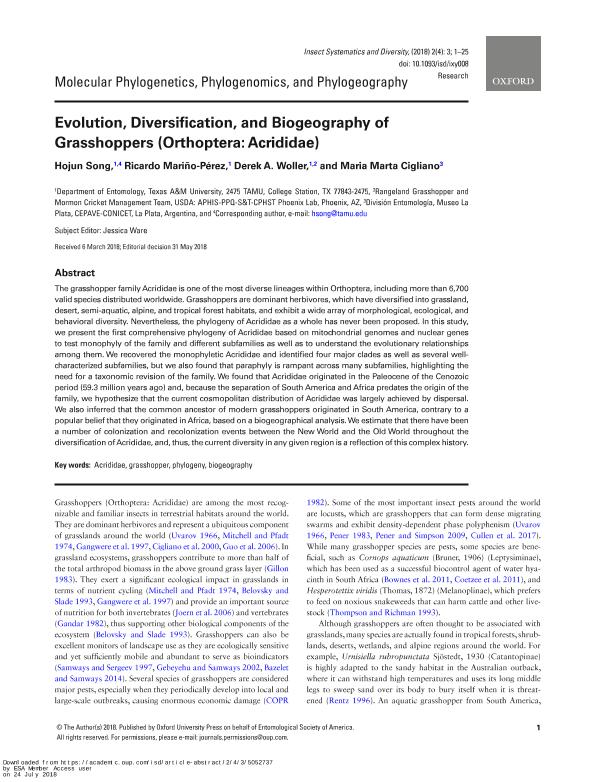Mostrar el registro sencillo del ítem
dc.contributor.author
Song, Hojun

dc.contributor.author
Mariño Pérez, Ricardo
dc.contributor.author
Woller, Derek A.
dc.contributor.author
Cigliano, Maria Marta

dc.date.available
2019-11-27T14:27:28Z
dc.date.issued
2018-07
dc.identifier.citation
Song, Hojun; Mariño Pérez, Ricardo; Woller, Derek A.; Cigliano, Maria Marta; Evolution, diversification, and biogeography of grasshoppers (Orthoptera: Acrididae); Oxford Academic; Insect Systematics and Diversity; 2; 3; 7-2018; 1-25
dc.identifier.issn
2399-3421
dc.identifier.uri
http://hdl.handle.net/11336/90640
dc.description.abstract
The grasshopper family Acrididae is one of the most diverse lineages within Orthoptera, including more than 6,700 valid species distributed worldwide. Grasshoppers are dominant herbivores and represent a ubiquitous component of grasslands around the world. They have also diversified into desert, semi-aquatic, alpine, and tropical forest habitats, and exhibit a wide array of morphological, ecological, and behavioral diversity. Despite their diversity and our familiarity with grasshoppers, there has not been a comprehensive phylogenetic hypothesis for the Acrididae. In this study, we propose the first comprehensive phylogeny of Acrididae based on the mitochondrial genomes and nuclear genes to test monophyly of the family and different subfamilies as well as to understand the evolutionary relationships among these groups. We recovered the family as a monophyletic group and inferred that the common ancestor of modern grasshoppers originated in South America based on a biogeographic analysis. Within Acrididae, we recovered four major clades as well as several well-characterized subfamilies, but we also found that paraphyly is rampant across many subfamilies, highlighting the need for a taxonomic revision of the family. The divergence time estimate analysis suggested that Acrididae originated in the Paleocene of the Cenozoic period (59.3 MYA) and the diversification of the family can be characterized as a series of founder events with subsequent radiation. Because the separation of South America and Africa predated the origin of the family, we hypothesize that the current cosmopolitan distribution of Acrididae is largely achieved by dispersal. We estimate that there have been a number of colonization and recolonization events between the New World and the Old World throughout the diversification of Acrididae, and thus the current diversity in any given region is a reflection of this complex history.
dc.format
application/pdf
dc.language.iso
eng
dc.publisher
Oxford Academic
dc.rights
info:eu-repo/semantics/openAccess
dc.rights.uri
https://creativecommons.org/licenses/by-nc-sa/2.5/ar/
dc.subject
ACRIDIDAE
dc.subject
GRASSHOPPERS
dc.subject
PHYLOGENY
dc.subject
BIOGEOGRAPHY
dc.subject.classification
Otras Ciencias Naturales y Exactas

dc.subject.classification
Otras Ciencias Naturales y Exactas

dc.subject.classification
CIENCIAS NATURALES Y EXACTAS

dc.title
Evolution, diversification, and biogeography of grasshoppers (Orthoptera: Acrididae)
dc.type
info:eu-repo/semantics/article
dc.type
info:ar-repo/semantics/artículo
dc.type
info:eu-repo/semantics/publishedVersion
dc.date.updated
2019-10-17T14:08:00Z
dc.journal.volume
2
dc.journal.number
3
dc.journal.pagination
1-25
dc.journal.pais
Estados Unidos

dc.description.fil
Fil: Song, Hojun. Texas A&M University; Estados Unidos. Consejo Nacional de Investigaciones Científicas y Técnicas; Argentina
dc.description.fil
Fil: Mariño Pérez, Ricardo. Texas A&M University; Estados Unidos
dc.description.fil
Fil: Woller, Derek A.. Texas A&M University; Estados Unidos
dc.description.fil
Fil: Cigliano, Maria Marta. Consejo Nacional de Investigaciones Científicas y Técnicas. Centro Científico Tecnológico Conicet - La Plata. Centro de Estudios Parasitológicos y de Vectores. Universidad Nacional de La Plata. Facultad de Ciencias Naturales y Museo. Centro de Estudios Parasitológicos y de Vectores; Argentina
dc.journal.title
Insect Systematics and Diversity
dc.relation.alternativeid
info:eu-repo/semantics/altIdentifier/doi/http://dx.doi.org/10.1093/isd/ixy008
dc.relation.alternativeid
info:eu-repo/semantics/altIdentifier/url/https://academic.oup.com/isd/article/2/4/3/5052737
Archivos asociados
